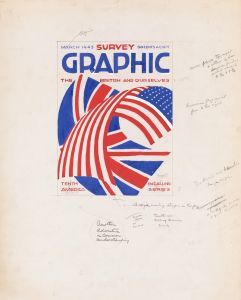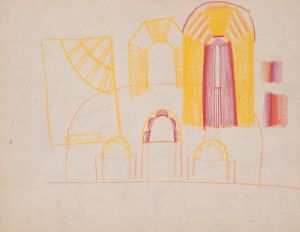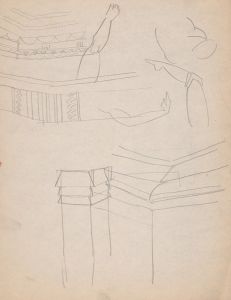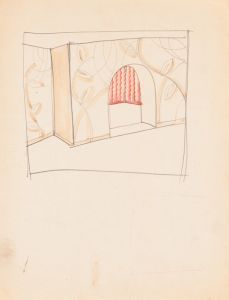
Design drawings for miscellaneous interiors, some possibly related to the Hotel St. George, New York, NY Sketch for miscellaneous interior
A hand-painted replica of Winold Reiss’s masterpiece Design drawings for miscellaneous interiors, some possibly related to the Hotel St. George, New York, NY Sketch for miscellaneous interior, meticulously crafted by professional artists to capture the true essence of the original. Each piece is created with museum-quality canvas and rare mineral pigments, carefully painted by experienced artists with delicate brushstrokes and rich, layered colors to perfectly recreate the texture of the original artwork. Unlike machine-printed reproductions, this hand-painted version brings the painting to life, infused with the artist’s emotions and skill in every stroke. Whether for personal collection or home decoration, it instantly elevates the artistic atmosphere of any space.
Winold Reiss (1886–1953) was a German-American artist and designer known for his contributions to interior design, portraiture, and graphic arts. His work often combined elements of European modernism with American themes, reflecting his unique artistic vision. Among his many projects, Reiss created design drawings for various interiors, some of which may have been associated with the Hotel St. George in Brooklyn, New York.
The Hotel St. George, once a prominent landmark in Brooklyn Heights, was known for its grandeur and luxurious interiors during the early to mid-20th century. While specific details about the connection between Reiss's design drawings and the hotel remain unclear, his sketches for miscellaneous interiors showcase his characteristic style, which often included bold geometric patterns, vibrant colors, and an emphasis on harmony between form and function. These designs were likely intended for decorative purposes, reflecting the aesthetic trends of the time.
Reiss's work in interior design extended beyond the Hotel St. George. He was widely recognized for his ability to create immersive environments, blending artistic innovation with practical design. His contributions to public spaces, such as restaurants, theaters, and hotels, often featured intricate murals, custom furniture, and decorative elements that highlighted his attention to detail and artistic versatility.
The sketches attributed to Reiss for miscellaneous interiors demonstrate his skill in conceptualizing spaces that were both visually striking and functional. While the exact purpose or location of these designs is not definitively documented, they remain an important part of his artistic legacy, illustrating his influence on American interior design during the early 20th century.
No further specific information about these particular design drawings or their intended use is available.





![Posters for Charity Bazar [i.e. Bazaar] for the widows and orphans of German, Austrian, Hungarian and their allied soldiers, March 23rd, 1916, New York, NY](/imgs/249259/s/winold-reiss-posters-for-charity-bazar-ie-bazaar-for-the-widows-and-orphans-of-german-austrian-hungarian-and-their-allied-soldiers-march-23rd-1916-new-york-ny-35f5cec1.jpg)

![Design drawings for Club Gallant project, New York, NY.] [Study for Club Gallant exterior](/imgs/249273/s/winold-reiss-design-drawings-for-club-gallant-project-new-york-ny-study-for-club-gallant-exterior-822ea339.jpg)
![Design drawings for miscellaneous interiors, some possibly related to the Hotel St. George, New York, NY.] [Sketch for miscellaneous interior .](/imgs/249277/s/winold-reiss-design-drawings-for-miscellaneous-interiors-some-possibly-related-to-the-hotel-st-george-new-york-ny-sketch-for-miscellaneous-interior--6b46aedb.jpg)
![Design drawings for miscellaneous interiors, some possibly related to the Hotel St. George, New York, NY.] [Sketch for miscellaneous interior](/imgs/249278/s/winold-reiss-design-drawings-for-miscellaneous-interiors-some-possibly-related-to-the-hotel-st-george-new-york-ny-sketch-for-miscellaneous-interior-28d93815.jpg)
![Drawings for proposed redecorations of Yorketowne Coffee Shop, Job #238, York, PA.] [Drawing #6, interior plans for tables, counters, benches](/imgs/249341/s/winold-reiss-drawings-for-proposed-redecorations-of-yorketowne-coffee-shop-job-238-york-pa-drawing-6-interior-plans-for-tables-counters-benches-c6e96b9c.jpg)

![Interior perspective drawings of Hotel Siwanoy, Mount Vernon, NY.] [Interior perspective study of Grill in yellow, blue, and green]](/imgs/249370/s/winold-reiss-interior-perspective-drawings-of-hotel-siwanoy-mount-vernon-ny-interior-perspective-study-of-grill-in-yellow-blue-and-green-bea2a60e.jpg)
![Designs for theater with black-framed proscenium and boldly colored settings.] [Study for stage light wall decoration, possibly for Caf ̌Crillon](/imgs/249423/s/winold-reiss-designs-for-theater-with-blackframed-proscenium-and-boldly-colored-settings-study-for-stage-light-wall-decoration-possibly-for-caf-crillon-5f9976e0.jpg)
![Miscellaneous small sketches for inlaid table tops.] [Design with green lines and yellow wave motif](/imgs/249436/s/winold-reiss-miscellaneous-small-sketches-for-inlaid-table-tops-design-with-green-lines-and-yellow-wave-motif-474c01c.jpg)


